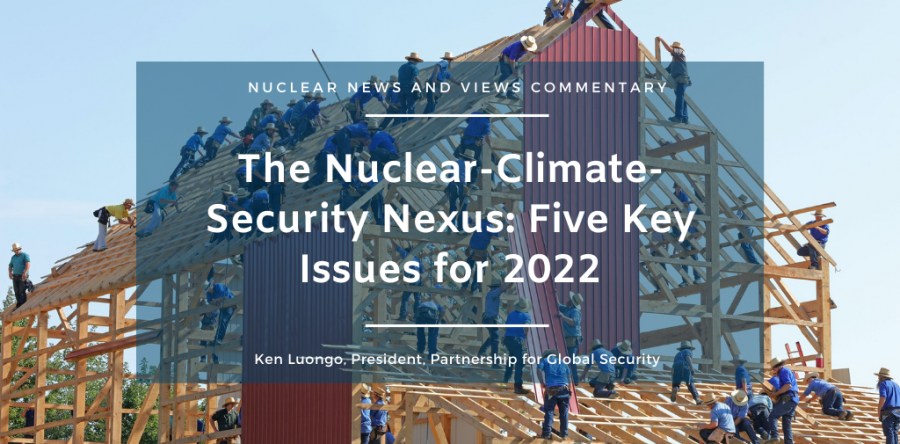This year the climate-nuclear-security nexus entered the mainstream. Now the stakes for success are more serious. There are five major issues that need to be addressed in 2022 to continue this year’s progress.
The most high-profile issue is sustaining the rising acceptance of nuclear energy as a major contributor to the global quest for zero-carbon energy.
In 2021, a number of nations made positive statements about the need for nuclear power as both a foundation of stable zero-carbon energy production and a complement to renewable energy, including the U.S., U.K., Canada, Russia, China, India, and Brazil.
The president of the European Union all but asserted that nuclear energy would be part of the EU clean energy taxonomy. Although that bruising battle for inclusion continues, the Netherlands is the latest nation to re-commit to nuclear energy as part of its climate objectives. And they join countries in Central and Eastern Europe that are exploring the expansion of nuclear energy to replace fossil fuels.
Perhaps most surprising was the reversal of position by three nations, Japan, South Korea, and France, on the value of nuclear energy in meeting their clean energy commitments by mid-century.
This shift has political, economic, and energy roots. Japan has a new prime minister and France and South Korea have major upcoming elections. But the swing was helped along by the demonstration of renewable energy intermittency in Britain, the gouging gas prices delivered from Russia, and the intensifying technology competition with China.
The second issue for 2022 is making more progress on the development, licensing, and preparation for demonstration of the next generation of small reactors. The U.S. has committed significant resources to the development and demonstration of both small modular and advanced reactors. But other governments are also aggressively pursuing these technologies, including Canada, France, South Korea, Japan, Russia, and China.
There are two key questions for the democratic nations on this list.
First is whether they will sustain this technology development effort through to successful completion or wilt in the face of inevitable setbacks, complications, and criticism. Second is whether they will find a way to cooperate or compete with one another.
The answer will impact the third key issue for next year - nuclear export and geopolitics.
There is a pressing need to devise a way to overcome the significant advantages that Russia and China have in the next-gen nuclear market. Russia is already dominating the large reactor export business, although opportunities in Central and Eastern Europe are now skewing toward the U.S. And it already has deployed a small floating reactor, has deep state-backed financing, and has signed nuclear agreements with dozens of nations, preparing the way for its technology.
China has made major inroads in the developing economy world through the Belt and Road Initiative, which is financing many energy and infrastructure projects. While it has been stymied in exporting large reactors to the U.K. and Eastern Europe, the BRI relationships can provide a conveyor belt for its small reactor exports.
The U.S. and its democratic allies are not yet doing enough to counter Russia and China by cultivating the nations that are most interested in next-gen nuclear power. There is no clear strategy for securing commitments from key export market nations. And there’s not enough money or creative thinking about how to build nuclear energy support capabilities in these nations that are connected to democratic nation technologies and standards.
The control of the export market will impact the fourth major issue for 2022 - effectively evolving nuclear nonproliferation and security requirements for next-gen reactors. Historically, the nations that dominate the market write the rules.
Adapting safeguards to reactors that are fueled online rather than through traditional methods is a serious issue that needs a high-standards response. The leading fuel cycles are emerging, and the pace of safeguards adaptation needs to be quickened.
Because these reactors will be smaller and potentially remotely deployed they could face different security vulnerabilities. Dangerous global neighborhoods with active terrorist organizations are a particular concern. The security of these reactors is paramount with new approaches required.
Finally, there’s finance. The recent decision to take NuScale public through a special purpose acquisition company opens the opportunity for increased private sector investment. This, potentially, is an important step forward for emerging nuclear companies, which have been very dependent on government financing, smaller scale private investment, or in the case of NuScale, major investment from a parent corporation. The development of this SPAC deal will be watched. If shareholders approve it that could catapult next-gen nuclear into the investment mainstream, unlocking new finance streams.
This year was pivotal for the nuclear-climate-security nexus. It has emerged as an important intersection of critical global challenges. But complacency in the face of this year’s success is not an option.
Ken Luongo, President, Partnership for Global Security


